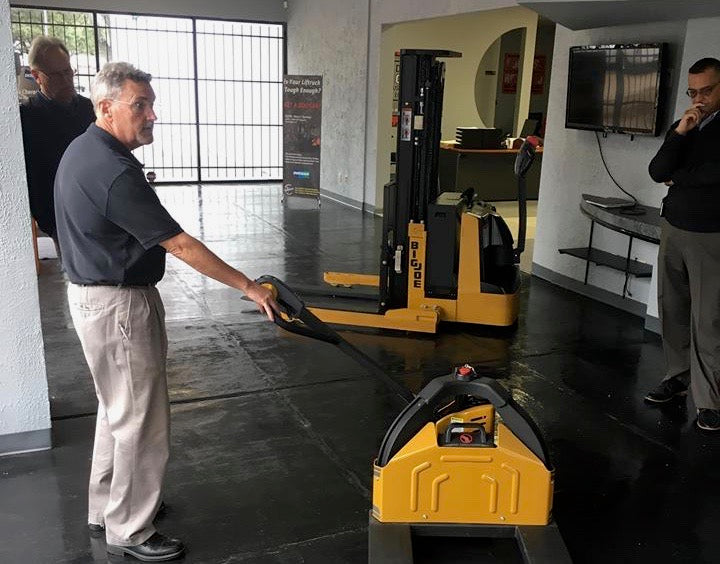By Chris Kuny
Regional Sales Manager
There is an old parable floating around the internet about “The space shuttle and a horse’s behind” that illustrates how specifications can live on forever. The author essentially draws a line in which the spacing of two horses pulling a Roman chariot (an Imperial standard) created a transportation specification that influenced the design of NASA’s space shuttle. Because the chariots created road ruts, and those roads were used for centuries, all future European wagons were built to fit the existing rutted roads. The wainwrights who built the wagons became the forefathers to the first English rail car builders, and English investors built America’s first railroads. The booster rockets used by the space shuttle had to be shipped by rail from the factory to Cape Kennedy, and thus their size was limited to the maximum width that could fit on a rail car whose wheelbase was determined by road ruts made by Roman chariots some 20 centuries ago.
It’s an amusing story that can get a chuckle out of your friends on a Saturday night – especially after a beer or two, but it does have some merit as a teaching tool for the Material Handling Industry. Take for example, the pallet.
The pallet as we know has been around for about ninety years. It can be made wood, plastic, composite or metal in a number of standardized sizes that have evolved over time for specific industries. Hundreds of millions are made, bought, sold, moved and destroyed all around the world each year with little regard to their importance in our Global economy.
Pallets dictate the flow of goods globally.
We focus on the goods stacked on the pallet without considering the support that this literal backbone of the Material Handling Industry provides. If you stop for a moment and consider how pallets dictate the flow of materials through your system, they’re possibly one of the most important pieces of equipment in the industry. I believe our entire world is dictated by the humble pallet. They impact everything from the way a trailer is loaded to the type of racking used for storage through the layout of the DC and even the specs of the forklift used to move them from point A to point B in the giant chess game called Logistics.

Let’s take your receiving, for instance. Say your inventory comes in on 48” x 40” pallets, a safe bet since it’s the most common size in the US. Two pallets fit side by side in the 102” standard trailer with enough room to move one without binding up on its neighbor. You unload them with a pallet jack or lift truck whose forks were manufactured to fit under the deck and around the center stringer of that pallet. Now we’ve identified expensive two pieces of equipment that were designed, in part to accommodate a “commodity product” that is made, used and scrapped daily. When you think about the number of trailers on the road and the number of lift trucks moving through warehouses in just the US alone the pallet’s impact is staggering. In all actuality, the entire lift truck industry exists as a means to move pallets.
Once the load hits the dock, it gets moved into your warehouse where you’ve set your racking to accommodate THE DIMENSIONS OF THE PALLET. There are countless miles of steel racking stretching from floor to ceiling in DCs from coast to coast. It’s expensive to make, transport and install and it’s all there for just one purpose - to efficiently store and support tons and tons of palletized goods. Depending on your business, the items on those pallets may be processed, converted, manufactured, assembled, transferred, sold and shipped a dozen or more times, and there is almost always a pallet silently supporting it. For decades the pallet has been a reliable constant in the Material Handling Industry, even though there are over a dozen “standard” sizes for products as diverse as groceries and 55 gallon drums.
Of course, the Greek philosopher Heraclitus said “The only constant in life is change.”
Recently, automation and RFID have pushed innovations throughout the DC and they have affected the palletizing concept as well, but the real driving change in our industry is the internet fulfillment. We are seeing it occurring for the first time in decades as JIT delivery, internet fulfillment, and last mile delivery systems take hold throughout the industry. Big DCs are giving way to smaller localized warehouses where smaller orders are shipped more frequently and individually picked pieces are delivered direct to the consumer. We are also seeing big box stores using their retail locations as de facto warehouses where items on the store floor are considered still in the supply chain and subject to shipping to the consumer.
Specifications are changing, don’t get stuck in a rut!

So what about the pallet? As shipments are broken down to smaller and smaller incremental units, full sized pallets become less and less efficient, especially in that last mile. Large orders that used to be assembled for delivery to retail operations are no longer the norm as each picking grows with every internet order placed. The half pallet, long a favorite of C-stores is becoming more prevalent in delivery systems. Four half pallets with individualized orders can be placed side by side in an eight-foot container, creating maximum order density per delivery. Assembling complete palletized orders with warehouse personnel also provides a significant wage savings verses having a C class driver assembling orders in the parking lot of a retail operation. These smaller orders can be sent from warehouses in lift gate style trucks for order building near the delivery point and require less expensive, lighter duty pallet trucks to handle the tasks.
Big Joe’s E-30 pallet truck excels in this function and the 22” wide chassis variant happens to be the only narrow-gauge fully-powered pallet truck on the market. It was designed specifically for half pallets and with a 3,000 lb. capacity, has more than enough capability to move a full load at a very reasonable price point. The E-30 will fit on every powered lift gate made for the US market from cargo vans to box trucks, giving drivers access to a powerful and affordable logistics combination for faster, injury free deliveries. As we can see, the pallet’s dimensions may have changed, it is still dictating the flow of materials through the supply chain.

These pressures that internet fulfillment are forcing on the material handling industry will change the way equipment purchases are made. Logistics companies are replacing big riding forklifts with powered pallet jacks and using smaller delivery vehicles making multiple stops instead of tractor trailers moving massive loads. Of course, it’s because the expense to own and operate these large pieces of capital equipment is not justified for handling the smaller orders and half pallet logistics.
Back in the DC, the half pallet requires less floor space in staging areas and smaller, less expensive equipment to move about. When orders are picked to half pallets, less space is wasted per truckload which saves in every aspect of transportation from fuel to payroll. There is also a rapidly expanding need for smaller, more agile equipment to handle the way orders are organized, with more SKUs and pick faces wedged into fewer square feet. The Joey family of Task Support Vehicles fills this niche precisely with its ability to maneuver in tight aisles that have been condensed down to as little as 50” while providing access to goods stored in racking over twenty feet high. Again, a smaller vehicle is taking the place of a larger lift truck to service the “Amazon Effect” on traditional warehousing. Big Joe is ahead of the game in innovation with five different models of Joey to fit the needs of warehouses and DCs large and small.
I have been a part of this industry for decades and I can honestly say that there has been more change in the last five years than at any point in my history. We’re breaking down big bulk orders and focusing on JIT delivery to smaller warehouses, with each picking and individualized order deliveries impacting the flow of logistics worldwide. I don’t think the pallet will ever go away, it is just too useful, but we are seeing the entire system of palletized goods transform thanks to on-line shopping. I know I started out talking about the longevity of a specification and I know I’m at least half right when it comes to half pallets!

